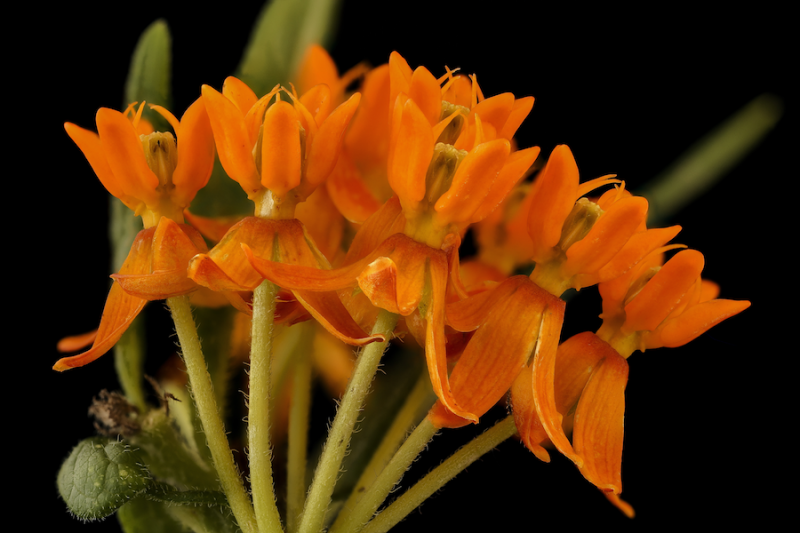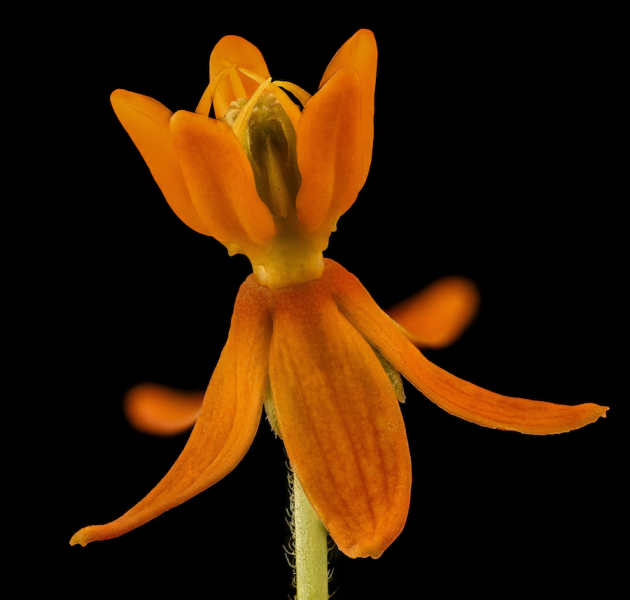
Pleurisy is a disease caused by an inflammation of the pleura, the lining of the chest cavity and lungs. Normally when breathing in and out, the lungs slide smoothly along the slick surface of the pleura. When these tissues become inflamed, the lungs catch and don't glide smoothly causing pain and difficulty breathing. If you’ve ever had pleurisy, you know how painful it is.
Pleurisy root is one of the few herbs that I think of as a specific. A specific is a remedy that is extremely helpful for recovering from particular condition. In this case, the very name, pleurisy root, suggests its incredible value as a specific remedy for pleurisy.
 I’ve had pleurisy twice. Both times I’ve relied on pleurisy root to relieve the problem. The second time I had pleurisy was the worst. I was teaching at Thomas Easley’s herb school in North Carolina. I was staying alone in the guest house when I started struggling to breathe as I was getting ready to sleep. Each breath was labored and painful. The pain got worse if I tried to lie down, so I had to sit up in bed preventing me from sleeping.
I’ve had pleurisy twice. Both times I’ve relied on pleurisy root to relieve the problem. The second time I had pleurisy was the worst. I was teaching at Thomas Easley’s herb school in North Carolina. I was staying alone in the guest house when I started struggling to breathe as I was getting ready to sleep. Each breath was labored and painful. The pain got worse if I tried to lie down, so I had to sit up in bed preventing me from sleeping.
After searching for a few minutes, I was fortunate to find some herbal tinctures that Matthew Wood had made and left in the kitchen of the guest house. I took some of the pleurisy root tincture, along with some lobelia, dosing myself every 15 minutes or so. After a couple hours, I was able to finally breathe more easily and get some sleep. Continuing to use these remedies, I was able to not only do my teaching but actually get completely well over the next day or two.
Beyond Pleurisy
Pleurisy root is more than just a great specific remedy for pleurisy. Michael Moore explains the action of it more fully in his Medicinal Plants of the Mountain West. He says:
Pleurisy root, as a gestalt, tends to stimulate skin and mucosal circulation, sebaceous secretions, and sweat; therefore it can be used with great success in tonic formulas for both dry skin and hair, frequent nighttime urination, and generally poor adaptability to changes in heat and humidity. This all derives from our body’s tendency to balance everyday fluid mechanics and blood chemistry between the lungs, kidneys, and skin. Pleurisy root shifts dominance to the lungs and skin and away from the kidneys. Folks with a pattern of adrenal stress and blood sugar ups and downs often manifest dry skin and mucosa and somewhat compromised pulmonary function.
In short, the pattern for pleurisy root is long-term stress, resulting in dry skin and problems with the lungs. In the Earthwise Herbal: A Complete Guide to New World Medicinal Plants, Matthew Wood elaborates on this pattern. He says it is helpful for coughs where the upper part of the lung is dry, but there is fluid in the lower lungs. It also helps coughs that are “tight, dry, and constricted.” Furthermore, pleurisy toot can be a helpful remedy for any kind of chest pain related to the lungs, including pain from coughing too much.
So, if one needs to balance moisture in the lungs, reduce pain in the chest, and ease inflammation in the lungs and chest, pleurisy root may be helpful. All this makes it a potential ingredient in formulas for respiratory problems like pneumonia, bronchitis, and asthma, provided that the tissue conditions associated with them match the previously given indications.
Other Uses for Pleurisy Root
 Pleurisy root may also be helpful for muscle and joint problems where there is a need for joint lubrication (“creaky joints”). It can also be helpful for skin problems where the skin is dry and hot. I’m not aware of any specific emotional indications for pleurisy root, but I do think chronic lung problems and difficulty breathing may be signs that a person feels stifled and has things they need to “get off their chest.” The brightly colored flowers are vibrant and alive, which is the opposite of feeling dull and repressed.
Pleurisy root may also be helpful for muscle and joint problems where there is a need for joint lubrication (“creaky joints”). It can also be helpful for skin problems where the skin is dry and hot. I’m not aware of any specific emotional indications for pleurisy root, but I do think chronic lung problems and difficulty breathing may be signs that a person feels stifled and has things they need to “get off their chest.” The brightly colored flowers are vibrant and alive, which is the opposite of feeling dull and repressed.
FES Services uses a different species, Asclepois corifolia, as a remedy for people who dull their consciousness through drugs, alcohol, overeating, or other practices to escape from having to look at what’s inside of themselves. So, I think pleurisy root may help a person look at what’s suppressing their life energy (breathing) and bring a vibrant awareness that allows them to release it.
Pleurisy root is also called butterfly weed and it’s a beautiful plant. A member of the milkweed family, it gets its other common name by its ability to attract butterflies in the garden. So, you might want to grow it as an ornamental in your garden.
Downloads
Steven's Articles
August
-

-
Monkeyflowers
Flower essences to help see ourselves more clearly…
-

-
Mariposa Lilies
Strengthening the bond between mother and child…
-

-
The Noble Bay Leaf
A common kitchen herb for aiding digestion and…
-

-
Epimedium: Horny Goat Weed
A circulatory stimulant and kidney yang tonic…
July
-

-
The Medicinal and Nutritional Benefits of Apricots
A nutritious fruit and valuable medicinal seed for coughs
-

-
Dogwoods
Asian dogwood is used to stop excessive discharge,…
June
-

-
Neem: The Village Pharmacy
A popular Ayurvedic remedy for dental and immune…
-

-
Spilanthes: The Toothache Plant
A traditional remedy for teeth and gums, as well…
-

-
Forsythia
An anti-inflammatory, fever-reducing, and infection fighting herb
May
-

-
Buckwheat (Kashi)
A delicious, high protein, gluten-free, gut-healthy food
-

-
Leaky Gut Syndrome
Plugging the leaks on the underlying cause of…
-

-
Storksbill
An edible, medicinal, weedy herb, helpful for…
April
-

-
Millet
Low glycemic, gluten-free, hypoallergenic grains…
-

-
Rice: The World's Most Popular Grain
The health-promoting and medicinal benefits of…
-

-
Tangerine, Mandarin, and Lime
Three citrus essential oils with an uplifting…

